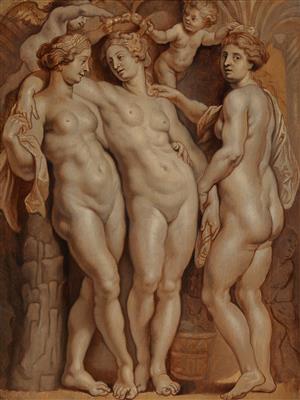Workshop of Peter Paul Rubens

(Siegen 1577–1640 Antwerp)
The Three Graces,
oil on panel, 46 x 33.5 cm, framed
The female figures depicted in the present composition can be identified as the three Graces Thalia, Aglaea, and Euphrosyne, daughters of Zeus. The present painting is a workshop variant based on a motif invented by Rubens. The version to which the present composition is most closely related was made around 1620–23 and is now in the Palazzo Pitti in Florence, another autograph version is preserved at the Museo del Prado, Madrid. The present painting dates from Rubens’s most productive phase and financially most successful years. His arrival in Antwerp coincided with the truce of 1609, which allowed the economy to recover as a whole. During his following years in Antwerp, the master received numerous prestigious commissions, including an altarpiece for the church of St. Bavo (The Raising of the Cross and The Deposition), an Assumption of the Virgin for the Cathedral of Our Lady, and an Adoration of the Magi for the Town Hall, meant to mark the signing of the truce. Rubens also worked for European courts – for the Habsburg and Medici families and for the English royal household – as well as members of the higher aristocracy. Among his clients were also patricians and the Jesuits, who fervently pursued the programme of the Counter-Reformation in their cultural policy. The artist was only able to cope with such a workload with the aid of a smoothly functioning workshop.
Even for such important commissions as the famous Ildefonso altarpiece Rubens employed numerous pupils and assistants, including Anthony van Dyck (1616–1620) and Jacob Jordaens (1615–1617). In a letter to Sir Dudley Carleton, the English envoi in The Hague, Rubens explained the collaborative practice of working together with his students, pointing out that a work he had invented and designed and which was finally retouched by him after it had been executed by his assistants must be considered an original (see Rooses/Ruelens, La Corerspondance de Rubens, vol. II, reprint Soest 1974, p. 139).
Specialist: Dr. Alexander Strasoldo
 Dr. Alexander Strasoldo
Dr. Alexander Strasoldo
+43-1-515 60-556
old.masters@dorotheum.com
17.10.2017 - 18:00
- Realized price: **
-
EUR 34,606.-
- Estimate:
-
EUR 40,000.- to EUR 60,000.-
Workshop of Peter Paul Rubens
(Siegen 1577–1640 Antwerp)
The Three Graces,
oil on panel, 46 x 33.5 cm, framed
The female figures depicted in the present composition can be identified as the three Graces Thalia, Aglaea, and Euphrosyne, daughters of Zeus. The present painting is a workshop variant based on a motif invented by Rubens. The version to which the present composition is most closely related was made around 1620–23 and is now in the Palazzo Pitti in Florence, another autograph version is preserved at the Museo del Prado, Madrid. The present painting dates from Rubens’s most productive phase and financially most successful years. His arrival in Antwerp coincided with the truce of 1609, which allowed the economy to recover as a whole. During his following years in Antwerp, the master received numerous prestigious commissions, including an altarpiece for the church of St. Bavo (The Raising of the Cross and The Deposition), an Assumption of the Virgin for the Cathedral of Our Lady, and an Adoration of the Magi for the Town Hall, meant to mark the signing of the truce. Rubens also worked for European courts – for the Habsburg and Medici families and for the English royal household – as well as members of the higher aristocracy. Among his clients were also patricians and the Jesuits, who fervently pursued the programme of the Counter-Reformation in their cultural policy. The artist was only able to cope with such a workload with the aid of a smoothly functioning workshop.
Even for such important commissions as the famous Ildefonso altarpiece Rubens employed numerous pupils and assistants, including Anthony van Dyck (1616–1620) and Jacob Jordaens (1615–1617). In a letter to Sir Dudley Carleton, the English envoi in The Hague, Rubens explained the collaborative practice of working together with his students, pointing out that a work he had invented and designed and which was finally retouched by him after it had been executed by his assistants must be considered an original (see Rooses/Ruelens, La Corerspondance de Rubens, vol. II, reprint Soest 1974, p. 139).
Specialist: Dr. Alexander Strasoldo
 Dr. Alexander Strasoldo
Dr. Alexander Strasoldo
+43-1-515 60-556
old.masters@dorotheum.com
|
Buyers hotline
Mon.-Fri.: 10.00am - 5.00pm
old.masters@dorotheum.at +43 1 515 60 403 |
| Auction: | Old Master Paintings |
| Auction type: | Saleroom auction |
| Date: | 17.10.2017 - 18:00 |
| Location: | Vienna | Palais Dorotheum |
| Exhibition: | 07.10. - 17.10.2017 |
** Purchase price incl. buyer's premium and VAT(Country of delivery: Austria)
It is not possible to turn in online buying orders anymore. The auction is in preparation or has been executed already.
